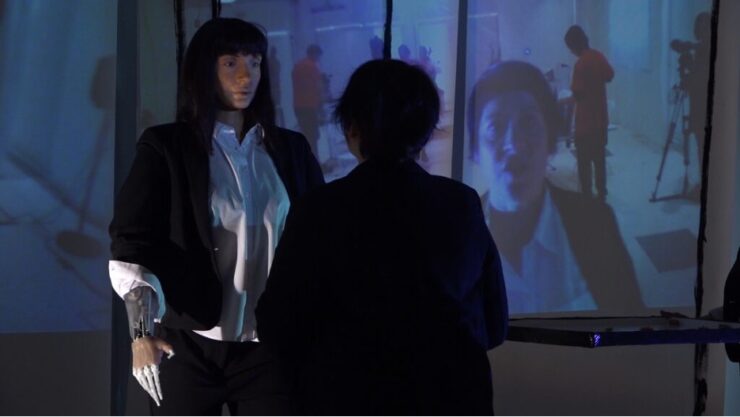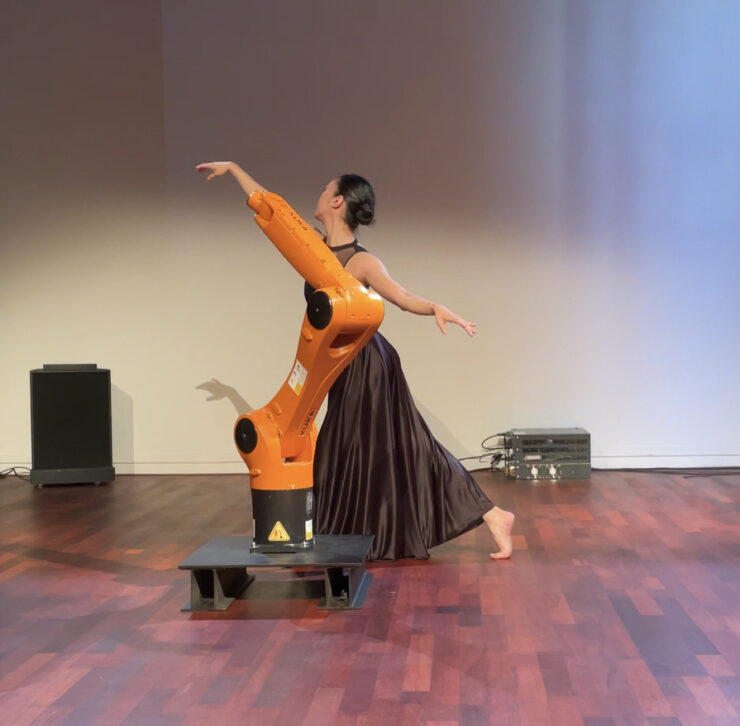Blog Posts
Robots in SPRING – Tom Watkins
** Link to event: UU & Academy: Robots in SPRING (SPRING academy and Utrecht University)
In the Acting Like a Robot exhibition, researchers shared and workshopped their projects that explore what theater can contribute to robotics and what robotics can contribute to the theater. These projects revealed the limitations of robots as thespians in their general physicality and abilities to dance and sing. While these limitations are apparent compared to a professional performer’s technical skills, the intent implicit in these projects highlights the reciprocal relationships between humans and machines. These projects made me question my relationship with the devices I interact with daily, the most common being my computer, phone, tablet, self-check-out register at Jumbo, and the automatic sliding door that opens when I enter or exit. I take these practical tools for granted, yet if they decided to stop working, my physical and mental state would be compromised. This hypersensitivity to interaction with machines in mundane life is an outcome of what theater can do to robots.
The work I found particularly interesting was Evelyn Ficarra’s robot opera Here, Kitty Kitty, and her work with Cleo the Mesmer robot. In her project with Cleo, she reveals the intent behind vocal expression through the lens of Cleo. This quite realistic-looking humanoid robot does not radically differ from the vocal expression intention of a professional opera singer.

Still from Robo_Op, singer Loré Lixenber with Cleo, a Mesmer robot created by Engineered Arts. Video documentation by Catalina Balan.
The materiality of one’s voice suggests where our origins are from. This may indicate a singer originating from classically based operatic training or more brightly projected musical theater. One’s vocal tendencies through vowel shape, sentence structure, or vocabulary may imply specific origins of a country where certain dialect characteristics are more prominent. Similarly, Ficarra revealed that Cleo was integrated with more believable human voice production than Pepper in her previous robot opera, Here, Kitty Kitty. Pepper, a far less realistic-looking humanoid robot void of flesh-like material and hair, was utilized similarly to explore the hybridity between humans and robots. Virtuosity through pitch and velocity was explored in Here, Kitty Kitty when Pepper expresses the desire to take the opera singer Loré Lixenber’s job. Ficarra programmed Pepper’s voice production to ‘sing’ at unintelligible extremities of pitch and speed. Lixenber then repeats Pepper’s vocalizations, perhaps to prove that her vocal faculties are on par with Pepper’s. While language and syntax are utterly void in this interaction, I got a sense of communication between Pepper and Lixenber. The vocal interactions between the two characters reminded me of the scat vocal stylings of Al Jarreau or Bob McFarrin, where language is not essential to communicate vocal emotion.
 In Soyun Jang’s presentation and performance “Dances with Spencer: ‘Tuning-In’ to a Robot,” she explores Heidegger’s work on attunement or Stimmung. “Attunement . . . is presented and analyzed as an essential element of the very organization of Dasein (human) access to the world” (Ruin 2000, 155). This organization includes Dasein’s current moods and state of mind, constantly negotiating with their view and access to the world. In Jang’s process of tuning-in, she highlights Spencer’s initial purpose as an industrial robot. However, this purpose is negotiated depending on where Spencer is and what she does. In a dance studio and performing arts environment, Spencer must be attuned differently than in an industrial setting. This attunement falls onto the programmer of the routine who chooses the music to dance to and the choreography of Spencer. However, the audience is responsible for tuning into the performance to recognize the interaction between Spencer and the human dancer to see Spencer more than an industrial robot.
In Soyun Jang’s presentation and performance “Dances with Spencer: ‘Tuning-In’ to a Robot,” she explores Heidegger’s work on attunement or Stimmung. “Attunement . . . is presented and analyzed as an essential element of the very organization of Dasein (human) access to the world” (Ruin 2000, 155). This organization includes Dasein’s current moods and state of mind, constantly negotiating with their view and access to the world. In Jang’s process of tuning-in, she highlights Spencer’s initial purpose as an industrial robot. However, this purpose is negotiated depending on where Spencer is and what she does. In a dance studio and performing arts environment, Spencer must be attuned differently than in an industrial setting. This attunement falls onto the programmer of the routine who chooses the music to dance to and the choreography of Spencer. However, the audience is responsible for tuning into the performance to recognize the interaction between Spencer and the human dancer to see Spencer more than an industrial robot.
I do not have a background in dance, yet I am a musician interested in improvisation and songwriting. Some interactions I tuned into during Soyun’s dance with Spencer were call and response, imitation, and using palindrome movements, all of which are powerful techniques and tools in improvisation and composition. It is interesting for me to speculate how Spencer may be able to tune into the dancer or the audience. Soyun did disclose that Spencer’s mechanics are not “smart enough” for such a task. However, recent research in Japan intersects art and technology by integrating sensors that allow their android, Alter, to “mimic the logic of neural circuits of living things” (Ogawa, Doi, Takashi, Ishiguro 2018, 64). This phenomenological ability of androids like Alter to learn movements in real-time allows for another layer of attunement that negotiates mood and access to the world. It also raises questions about what other human senses can be incorporated into robotics and AI that heighten their sense of attunement.
References
Doi, Itsuki, Ikegami, Taskashi, Ishiguro, Hiroshi, Ogawa, Kohei. 2018. “Alter.” CyberArts 2018 International Compendium. https://archive.aec.at/media/assets/27f344fc12b46f902fc0d023530516ce.pdf.
Ficarra, Evelyn. 29 June 2021. Still from Robo_Op, singer Loré Lixenber with Cleo, a Mesmer robot created by Engineered Arts. Video documentation by Catalina Balan.
Ruin, Hans. (2000). The Passivity of Reason – On Heidegger’s Concept of Stimmung. SATS. 1. 10.1515/SATS.2000.143.

